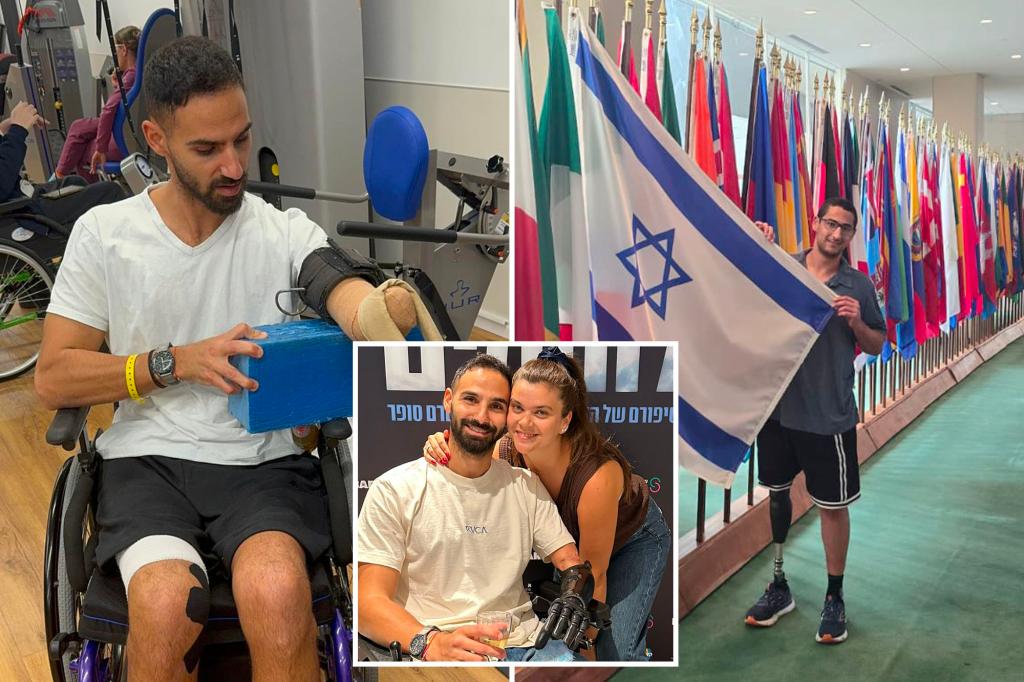For hundreds of injured Israel Defense Forces soldiers who have bravely fought to defend their country in the wake of the Oct. 7 terror attack, the path to recovery runs through New York City.
For Niv Shtaif, an IDF reservist who was paralyzed while fighting on the northern border in December 2023, coming to the Big Apple was a big first step toward reaching his dream — to walk down the aisle at his wedding.
An anti-tank missile left the 30-year-old with a spinal cord injury that confined him to a wheelchair.
“We decided to postpone because of the injury. I was in a wheelchair and I didn’t really want to marry like that,” Shtaif, a well-known soccer referee in Israel, told The Post about scrapping his 400-person nuptials that were supposed to take place last year.
“I made a promise – to walk to the chuppah [Jewish wedding canopy].”
Shtaif underwent transformative treatments in NYC that helped him walk again — and reclaim his confidence and independence.
The soccer buff, who also lost his left hand, also left the Big Apple with a lifesaving souvenir — a $100,000 mioelectric pattern recognition hand from Brooklyn’s Orthocraft, a world-class orthotic, prosthetic, and pedorthic care company.
“Israel doesn’t see so many amputees like this; they don’t have the capability,” said Rabbi Uriel Vigler, founder of the NYC-based Belev Echad, an organization that has brought more than 150 seriously injured soldiers stateside for treatment over the past two years.
“There are people who lost their ability to walk, people with life-altering injuries, and you can’t describe their gratitude for life,” said Hershey Dauber of Orthocraft.
“Their attitude is beyond anything you could imagine.”
The cost of prosthetics can be staggering. A hand could start at $100,000 and go up to $1 million, Dauber said, noting that the labor-intensive process is akin to putting together a jigsaw puzzle.
“It’s delicate wiring, troubleshooting,” he said.
Dr. Omri Ayalon, co-director of NYU’s Center for Amputation Reconstruction, also highlighted the extreme nature of the injuries they are treating.
“We’re dealing with blast injuries we typically don’t see on a regular basis,” he said.
“These are wartime injuries,” added the doctor, whose office has performed amputation reconstruction surgeries on dozens of soldiers since October 7.
Amit Bar, a Nahal Brigade reservist, lost his right leg after a building collapsed on him in Gaza in December 2023, killing two of his commanders.
“I thought I was dying,” he told The Post, recalling a harrowing helicopter ride back to Israel.
He then fell into a coma and woke up to the shock of being an amputee.
Now, after a six-week medical trip to New York, the 24-year-old is not only back to walking — but running.
Bar, who is an avid runner, received a full running prosthesis with a blade.
“Think of it like a slingshot,” said Dauber. “When you put your weight into it, it propels you forward.”
The technology reduces the impact on landing while providing the forward propulsion needed in running.
But Shtaif and Bar’s resilience and strength are all their own.
“You can ask why and cry or keep working, keep trying to change the situation from day to day for a better future,” Shtaif said.
In April, he walked at his own wedding, surrounded by exuberant family and friends.
“It’s been a hard journey to reach this point of standing under the chuppah,” he said ahead of the second anniversary of October 7. “But I am more than happy that I did it and I will remember it always.”
“It’s just a leg,” Bar said. “The most important thing is being alive.”
Read the full article here

